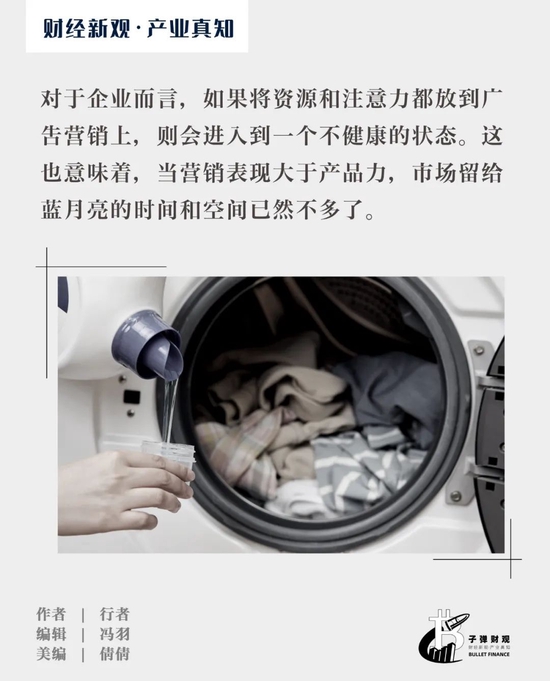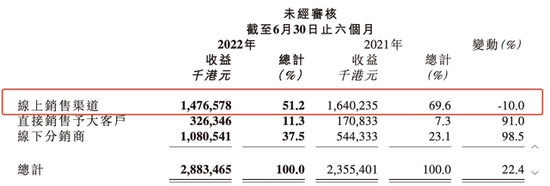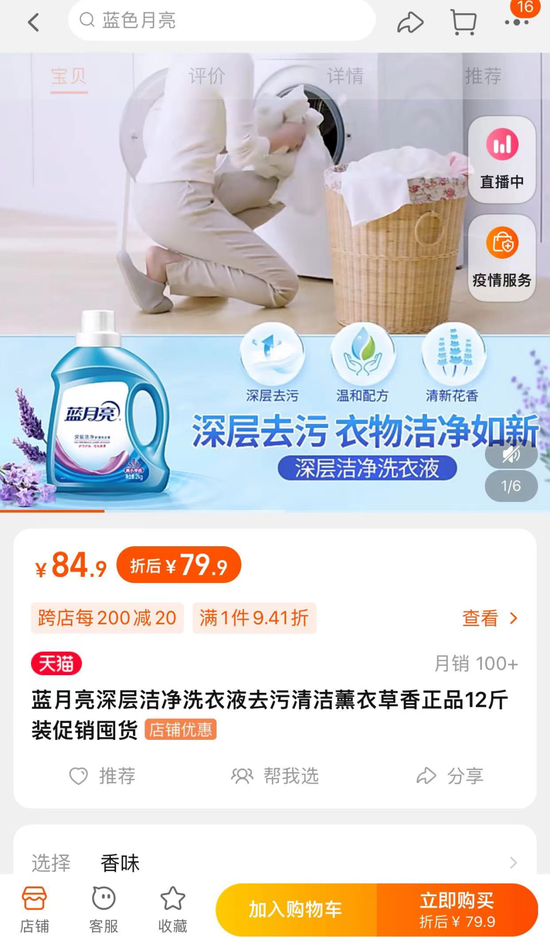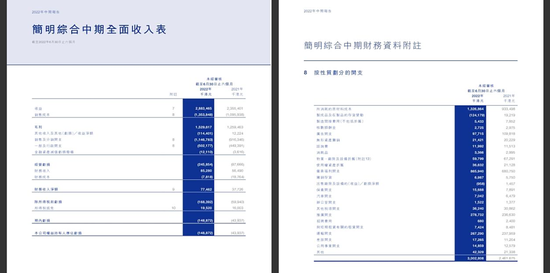
Welcome to the WeChat subscription number of “Sina Technology”: techsina
Text / Walker
Source: Bullet Finance View (ID: zidancaiguan)
Blue Moon likes to mention the hot search again.
A discussion topic named #和Blue Moon Together Yuedong Mid-Autumn Festival# rushed to the hot search on Weibo, with more than 20 million reads, ranking at the forefront of the Mid-Autumn Festival activities on the topic list.
Not only that, this year Blue Moon also sponsored the CCTV Mid-Autumn Festival Gala, and combined its Blue Moon User Festival with the Mid-Autumn Festival Gala. It is not difficult to see Blue Moon’s ambition to use the Mid-Autumn Festival for large-scale marketing.
According to the calculation of the price of CCTV sponsorship over the years, relevant people predict that the marketing investment of Blue Moon’s Mid-Autumn Festival series may exceed 50 million.
This kind of market investment regardless of cost is rare in the relatively sluggish market environment in the past year.
Blue Moon’s crazy marketing investment is not only affected by the excessive downward pressure on the stock price, but also related to the market performance not meeting the requirements.
Since the listing of Blue Moon, the stock price trend has been a downward curve, and there is no upward trend. Data shows that as of the close on October 5, Blue Moon’s share price was at HK$5.31, down 70% from the highest point of HK$18.95 in January 2021, leaving only HK$31.1 billion in market value.
Recently, the interim financial report released by Blue Moon also showed that although the revenue and sales in the first half of the year both increased, the loss remained, and the decline in the revenue of online main sales channels has also become an urgent problem for Blue Moon to solve.
The capital market has a keener sense of smell. The latest news shows that Citibank, which has been optimistic about Blue Moon, released a report saying that although Blue Moon’s management has a conservative view on the outlook for the second half of 2022, it is believed that the lowering of guidance when the profit warning was issued a month ago has prepared investors psychologically. The net profit forecast for Blue Moon in 2022, 2023, and 2024 was lowered by 37%, 22%, and 21%, respectively, the rating was lowered from “buy” to “neutral”, and the target price was lowered from HK$7.2 to HK$6.1.
Under multiple pressures, if the market performance is not good, it is necessary to continue to invest, and the investment will drive the increase of marketing expenses. As a result, it will enter a vicious circle of more and more losses.
This means that Blue Moon must make changes, otherwise it can only be abandoned by the capital market.
1
Stuck on high-priced raw materials
On August 25, 2022, Blue Moon Group, which is listed on the Hong Kong stock market, released its semi-annual report. The revenue and gross profit increased year-on-year, but the losses during the period were still increasing.
This seems to be the only label for Blue Moon’s operating data in recent years.
According to the report, in the first half of 2022, Blue Moon achieved a revenue of HK$2.883 billion, a year-on-year increase of 22.4%; a net loss of HK$149 million, an increase of HK$105 million over the same period last year.
Notably, its loss growth came against the backdrop of rising gross profit. Data shows that in the first half of the year, Blue Moon’s gross profit was HK$1.529 billion, an increase of 21.4% from HK$1.259 billion in the same period last year, and remained stable overall.
However, even though Blue Moon announced that most of its losses were due to exchange losses arising from the conversion of overseas RMB assets to the US dollar, except for this part of the so-called exchange losses, Blue Moon is still in a state of loss.
 Figure / Photo Network, based on VRF protocol
Figure / Photo Network, based on VRF protocol“Blue Moon announced in its own financial report that this part of the loss came from the loss of the company’s RMB assets in foreign exchange, which is incredible for the analyst group.” Lin Xi, a well-known analyst in Hong Kong, said to ‘Bullet Finance View’ that Blue Moon is overseas. There is no direct supplier of raw materials, and there is no overseas asset that needs to be purchased with US dollars. How the exchange loss is generated needs to be explained in detail by the company in the follow-up.
He further pointed out that the raw materials needed by Blue Moon are divided into two types, one is plastic for the outer shell, and the other is palm oil as a raw material for production. “Strictly speaking, the plastic of the shell should be ordered by the shell manufacturer. Blue Moon only needs the shell and does not directly purchase raw materials; on the other hand, there is a large market for palm oil sales in China, which can be purchased from China at a very transparent price, and does not need to be purchased overseas. Procurement.”
In addition, I haven’t heard of Blue Moon’s acquisition of overseas assets recently, so Lin Xi doesn’t know how this exchange loss occurred. “Even if the foreign exchange losses are removed by Blue Moon’s far-fetched reasons, the real loss of Blue Moon in the first half of the year is still HK$24.58 million, which is 2.5 times that of the same period last year.”
In fact, the real problem for Blue Moon right now is that costs are rising too fast, causing gross margins to fall faster and losses to rise faster than expected.
Generally speaking, gross profit margin can basically show the operating status of a company. Blue Moon’s financial report data shows that in the first half of 2020, the blue moon group’s gross profit margin was as high as 63.99%, and by the first half of 2022, it fell to 53.05%, and the gross profit margin dropped by 10.94 percentage points in two years.
The reason for the decline in gross profit margin is that it has a lot to do with the rise in raw materials. According to data from the interim report, the current operating cost of Blue Moon has risen from HK$1.096 billion in the first half of 2021 to HK$1.354 billion in the first half of 2022, an increase of about 23.5%, higher than the 22.4% growth rate of revenue. During the same period, the proportion of the company’s raw material costs to operating costs also increased from 85% to 98%.
In other words, the high cost of raw materials and thinning of the group’s profits may be the core issue that Blue Moon needs to pay attention to now.
2
It’s all “tossing”
In the financial report, it is not difficult to find the operation of Blue Moon by dismantling the sales channels.
According to the financial report data, Blue Moon’s sales channels are divided into three categories, namely online sales, offline distributors and direct sales to major customers. Among them, online sales channels are the main force. In the first half of 2022, the sales of these three channels were HKD 1.477 billion, HKD 1.081 billion and HKD 326 million respectively, accounting for 51.2%, 37.5% and 11.3% of revenue respectively.
Among them, online sales decreased by 10% compared with the same period in 2021, while sales of offline distributors increased by 98.5% year-on-year.
 Figure / Blue Moon Financial Report
Figure / Blue Moon Financial ReportIn the financial report, Blue Moon said, “In the first half of this year, the company continued to expand its sales and distribution network to convenience stores, fresh food supermarkets and small and medium-sized local stores through local distributors. It also plans to improve procurement and inventory management. The penetration rate of the product has deepened from urban areas in big cities to counties, townships and villages in China.”
This is the sinking market plan that Blue Moon laid out at the beginning of this year.
In fact, since 2015, Blue Moon’s market strategy has been in a swing, which has also made Blue Moon’s sales system extremely chaotic.
Since entering the laundry detergent market in 2009, Blue Moon has been relying on offline supermarkets to distribute goods on a large scale to occupy the market. At its peak, more than 50% of laundry detergents were produced by Blue Moon.
However, in 2015, due to the conflicts between Blue Moon and RT-Mart, Carrefour and other traditional supermarkets due to pricing issues, its products were also removed from the shelves of many stores. Later, Blue Moon prepared to build its own channels, and turned to the “Moon Cabin” in the shopping mall (the “Moon Cabin” physical store integrates sales, distribution and service, and adopts the O2O model).
Soon, Blue Moon found that Moon Cabin could not solve the problem of offline channels, and had to return to the traditional channels of supermarkets in 2017, but the lost time allowed competitors to catch up. On the other hand, Blue Moon has spent more than a year on channel building and sales staff, which has added heavy competitive pressure to it.
In a sense, the first round of “tossing” that ended in 2017 has depleted Blue Moon’s popularity and indirectly accelerated the rise of competitors such as Liby.
After this battle, Blue Moon’s advantages in offline channels have been weakened, and the product layout and discounts cannot be supported by supermarkets. In this case, Blue Moon has to shift its focus to online, trying to use online The rapid development of online channels replaces the profit acquisition of offline channels.
This also led to nearly 50% of Blue Moon’s revenue in 2019 coming from online channels. At that time, some industry observers even regarded Blue Moon as a model for the digitalization of fast-moving consumer goods.
At this point in time, Zhang Lei, the founder of Hillhouse Capital, wrote the case of Blue Moon into his book “Value”, and believed that Hillhouse Capital’s investment in Blue Moon was a very correct decision.
But in the second half of 2019, Blue Moon found that due to the strength of the platform, the brand’s online market gradually lost the pricing power of its own products. Whether it is the shopping festival of various platforms of Taobao and Jingdong, or the price subsidy of Pinduoduo, the price of Blue Moon’s online channels is much lower than that of offline channels.
Taking Blue Moon’s classic product laundry detergent as an example, on Taobao, a 12-pound laundry detergent is being sold in the official flagship store of Blue Moon for 84.9 yuan, or 79.9 yuan after discount. In shopping malls and offline channels, the lowest price of this laundry detergent is not less than 90 yuan.
 Figure / Taobao Blue Moon Flagship Store
Figure / Taobao Blue Moon Flagship StoreThis price confusion will inevitably have a huge impact on the sales of offline channels, and will also lead to a further decline in Blue Moon’s gross profit margin.
For this reason, Blue Moon had to announce that it would return to offline. This time their strategy was to enter the sinking market.
However, the same 12-pound laundry detergent is priced at 69.9 yuan, and the online discounted price is only 59.9 yuan. And Liby even has products around 55 yuan.
This means that Blue Moon’s products are at least 20-30 yuan more expensive than major competitors, and this pricing strategy is not dominant in offline channels, especially in the sinking market.
In order to promote the growth of offline sales, Blue Moon had to resort to the magic weapon of subsidies and increased market fees. The financial report shows that in the first half of this year, the company’s sales and distribution expenses were 1.146 billion Hong Kong dollars, an increase of 25.1% compared with 916 million Hong Kong dollars in the same period last year.
Blue Moon said that it was mainly due to the increase in the number of sales staff, which led to the increase in staff costs and the increase in offline channel marketing expenses. However, since 2017, the number of offline sales staff of Blue Moon has shown a downward trend, from the peak of 10,432 in 2017 to 4,582 in 2020.
Therefore, in the first half of the year, even if the sales staff increased the cost, it did not account for the bulk, and most of the sales expenses were still in subsidies and sponsorship of advertisements to first-line dealers.
This also further lowered the profit expectations of the outside world for Blue Moon.
3
Marketing is bigger than product
And today’s embarrassing scene may not have been imagined by the Blue Moon in its golden age.
At the beginning of 2009, Blue Moon held a press conference, officially announced its entry into the laundry detergent market, and spent 200 million yuan to sign the endorsement of Olympic champion Guo Jingjing.
When Tide, Omo, Bilang and other international brands did not promote laundry detergent in Huadu, Blue Moon took the lead and became the leading brand in the laundry detergent market with its strong product strength and the high popularity of Olympic champion Guo Jingjing. The slogan “Blue Moon, creating a new era of laundry in China” is deeply rooted in the hearts of the people, and the Blue Moon brand has become synonymous with laundry detergent. At the beginning of 2012, Blue Moon’s market share reached 52.7%.
Up to now, Blue Moon’s laundry detergent is still its core product. The latest interim report shows that Blue Moon’s laundry detergent accounts for more than 85% of its revenue.
Blue Moon is not without other new products. According to the data from the interim report, Blue Moon has launched a series of products for sports clothing cleaning in July this year, including a sports laundry detergent and a special laundry detergent for quick-drying fabrics; as early as 2021, Blue Moon has also launched underwear. Dedicated laundry detergent, but the market response is mediocre.
According to the financial report data, as of May 2022, Blue Moon has more than 90 SKUs, but so far, few single products can compete with traditional Blue Moon hand sanitizers and laundry detergents.
What is even more interesting is that although Blue Moon claims that it has a R&D team of several hundred people and core R&D personnel, mainly doctoral students, neither the 2021 annual report nor the 2022 mid-year report lists R&D expenses.
 Figure / Blue Moon Financial Report
Figure / Blue Moon Financial ReportSince then, the various laundry detergents launched by Blue Moon look more like products that have fine-tuned the original laundry detergent formula. In the opinion of some industry experts, its technical content is not high, and Blue Moon has not yet come up with an iterative product in the true sense.
On the contrary, competitors cut into the new blue ocean market from laundry beads and began to quickly overtake Blue Moon’s market share.
According to Guosen Securities research data, the sales of laundry beads in China increased from 1.5 million yuan in 2015 to 1.116 billion yuan in 2020, with a compound growth rate of 273.3%. Overseas, the market share of laundry beads in many markets has reached 20%.
At present, laundry bead brands are highly concentrated, and the concentration of Top 10 brands exceeds 63%. The top brands are basically concentrated in several well-known traditional daily chemical companies such as Procter & Gamble’s Bilang, Tide, and Dangni, Unilever’s Omo, Liby, and Willey’s Mom Yixuan.
In this segmented high-growth market, Blue Moon does not deeply participate in the original market, but it is difficult to realize its expectation of further increasing market share and making profits.
After all, for enterprises, if they put resources and attention on advertising and marketing, they will enter an unhealthy state. This also means that when the marketing performance is greater than the product strength, the market has little time and space for Blue Moon.
*The title picture in the article comes from: Photo Network, based on the VRF protocol.

(Disclaimer: This article only represents the author’s point of view and does not represent the position of Sina.com.)
This article is reproduced from: http://finance.sina.com.cn/tech/csj/2022-10-05/doc-imqmmtha9872350.shtml
This site is for inclusion only, and the copyright belongs to the original author.